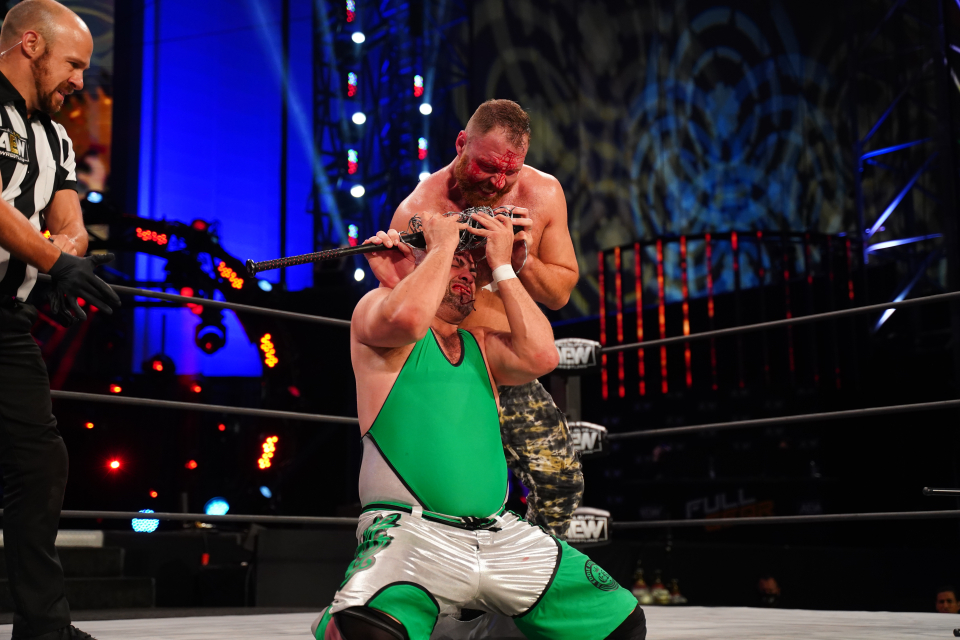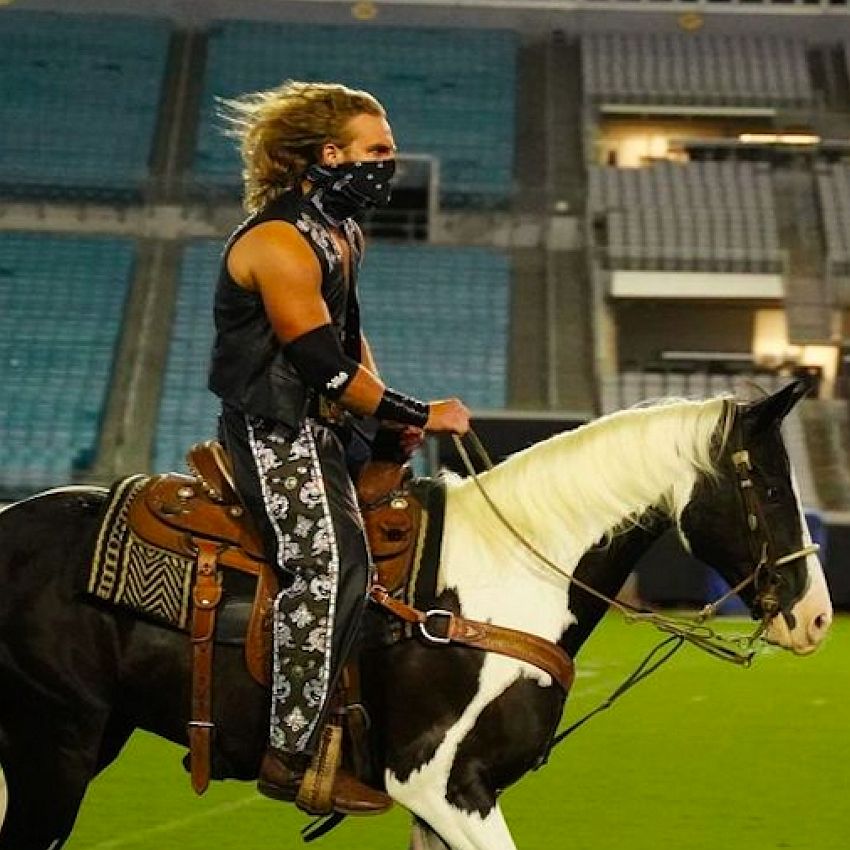
Photo courtesy of AEW
You could feel it in the years leading up to 2020; pro wrestling was well on its way to entering another boom period. The arrival of AEW signified a major competitor for the global juggernaut known as World Wrestling Entertainment, more and more small companies leveraged decent-to-pretty great TV deals, new independent promoters were cropping up damn near every weekend.
Then, the entire resurgence of the industry hit the brick wall known as COVID-19. The majors made the ill-advised move of soldiering on without really knowing the consequences; some indies did the same but most of them made the wise decision of sitting the pandemic out. Over the summer, a vast reckoning of the toxic masculinity and widespread abuse inherent in pro wrestling extant since the carnival days played out in the Speaking Out movement. (For extra context, please refer to this brilliant and heartbreaking piece by my Fanfyte colleague Colette Arrand, complete with firsthand accounts of sexual abuse described in nauseating detail.) Couple those events with many wrestlers spanning generations condoning and even openly supporting white supremacist-dominated fascism and you’ll find a landscape many decent people found harder than ever to remain fans of.
This list always has been and always will be a celebration of the art form that is professional wrestling, as difficult as it is to celebrate sometimes. For a lot of us, the art form provides not only a means of escape or hard-earned entertainment, but a sense of togetherness, to use simulated events to process real human emotions, and to have something to engage with as a community.
Even when the wrestling industry reveals itself as a cesspool, the art form is still the best. — Douglas Martin
HONORABLE MENTION: Suge D vs. Trish Adora (Pan Afrikan World Diaspora Wrestling Championship Match) (For the Culture; Game Changer Wrestling Collective)

Photo by Earl Gardiner
Of all the cool events COVID robbed us of, my mind keeps going back to the fact that For the Culture — indie wrestling’s first truly significant event exclusively spotlighting Black performers — could have been packed into an electric Wrestlemania Weekend atmosphere, filled with the kind of fans who usually only get to experience a Black wrestling fan experience at WaleMania. Instead, the event was postponed for nearly six months and held on an Indianapolis fairground, hosting one of the year’s very best wrestling cards in front of a thin crowd of masked fans who look like regular IWA Mid-South patrons.
(I’m not trying to diss, just saying the vibe turned out very differently from what I imagine it to have been intended.)
Suge Dunkerton went from the best kept secret of the international wrestling scene to one of the game’s rising stars because Chris Jericho gave him a lovably goofy nickname, while Trish Adora has taken the mantle of “best kept secret” with her immaculate reign as Pan Afrikan World Diaspora Wrestling Champion. (Black women have always been historically undervalued and pro wrestling, still structurally dominated by white men, is no different. In some areas it’s worse.)
Out of all the exciting matchups salivated over by fans that For the Culture delivered fully on, Sug challenging Adora for this, the prestigious title made more prestigious by it being one of the few to represent African-born and descended people, was the match I found myself thinking about the most since the event.
Going into the match, Suge was playing mind games with Adora, tweeting out that she — even as champion — has something to prove to the 18-year veteran. As she enters the ring, he holds the ropes open for her, a polite measure you do for someone older, daintier, weaker than you. Using his considerable experience in the United Kingdom wrestling scene, Suge affirms his status as one of pro wrestling’s top flight technicians in the match’s early going, but Adora — a fantastically talented technical wrestler in her own right — playfully keeps up with Sug, toying with him to a large degree.
After sending him out of the ring, she holds the ropes open for him while he kicks a chair down in frustration on the outside.
Technical wrestling is my favorite style partly because it is meditative. Two bodies flowing together and gnashing against each other at the same time. The chain wrestling broken up by sudden pin attempts; the grinding of submission holds. The cresting reversals, the bends and twists and turns. And when you’re outmatched, you punch your opponent in the stomach.
Suge insists the punch was an accident in the heat of the moment and Adora seems to believe him. Until he kicks her in the face right after.
The aggression is turned up on Suge’s end, using extra force and double stomps when he realizes this isn’t going to be an easy, purely technical match. Suge headbutts Adora and stomps on her fingers; Adora eventually returns with vicious chops and dazzling kicks. Adora hits her ace in the hole, Lariat Tubman, and Suge kicks out. He’s delirious from the maneuver, dazed and swearing at her. She hits a second Lariat Tubman and locks in a gnashing Rings of Saturn variation and retains her title.
When people say they don’t like intergender wrestling, when they say sexist things like “it’s not realistic,” it’s because they have yet to see the form done correctly. Place in the hands of two wrestlers as superbly talented as Suge D and Trish Adora, it’s turned into masterpiece theater. And given how Adora’s 2021 has been shaking out so far, it’s safe to say she’ll be discarding her “best kept secret” label very soon and with ease. — Douglas Martin
HONORABLE MENTION: Lee Moriarty vs. Daniel Makabe (Slam of the Axe; Southern Underground Pro/Game Changer Wrestling Collective)
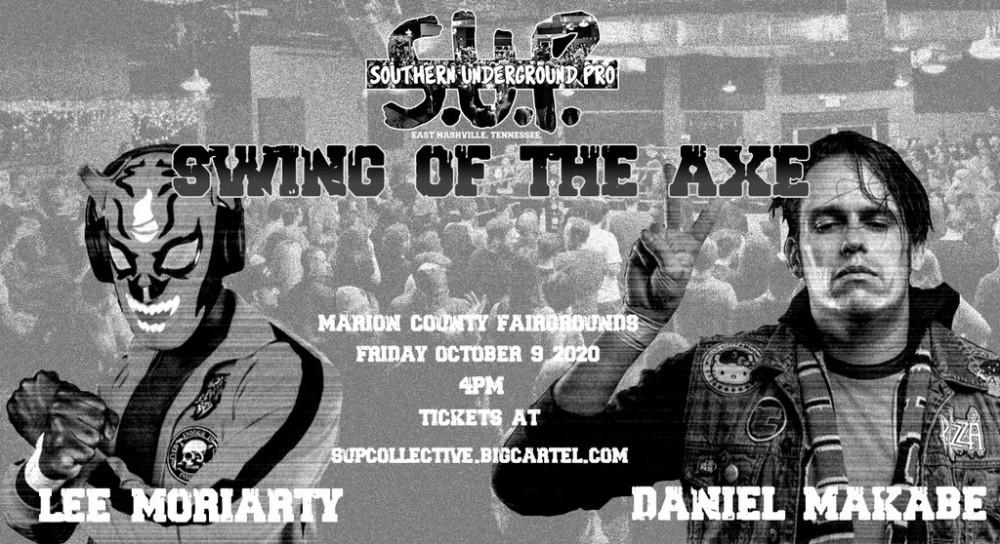
How it took until October 2020 for the two best young technical wrestlers — Lee Moriarty, master of the TAIGASTYLE and The Wrestling Genius Daniel Makabe — to tie each other up, makes no sense. Each in full control of the ring and his own presentation, they entered Southern Underground Pro’s “Slam of the Axe” with mighty expectations on their back.
The Auteur Theory of Pro Wrestling is typically a phrase I throw around when talking about promoters being overly controlling, but this one match showed how styles need not clash to gel perfectly. I could try and explain their interlocking holds and transitions, but I’d fail to do them justice. What’s more important is to declare that this match needs its roses, as it comes across a lot less choreographed than a lot of matches that got tons of praise.
Watching Moriarty and Makabe grapple each other like they’d worked each other on circuits for years, with truly liquid transitions mixed with the frustrations of being trapped in painful angles, I was in awe. In fact, I was reminded of why I fell in love with indie wrestling in the first place. Years ago, in a night club deep in Queens, NY, I got brain-drunk off of Zack Sabre Jr. and Timothy Thatcher and Drew Gulak going to war. If you missed this match in the thick fog of The Collective, go back and find it on FITE TV. The whole show is good, but this match is more than worth the price of admission. — Henry T. Casey
10. Hiromu Takahashi vs. El Desperado (Best of the Super Juniors Tournament Finals) (Best of the Super Juniors 27; New Japan Pro Wrestling)
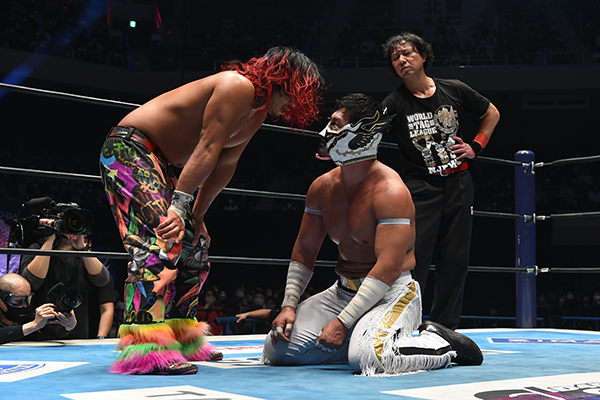
Photo courtesy of NJPW
After being postponed early in the calendar year for COVID reasons, the 2020 installment of New Japan’s annual Best of Super Juniors tournament arrived under less-than-ideal circumstances at the end of the year. The tournament shared cards with the promotion’s annual tag team tournament, was forced to follow the G1 Climax, was tightened to just one block of wrestlers instead of two, and featured almost no international talent—ACH, Lio Rush, Chris Bey, TJP, and Rey Horus instead appeared in the U.S.-based single-elimination Super J-Cup. But the final of BOSJ 2020 overcame those shortcomings; it was the culmination of a slow-burning feud between two of the division’s best storytellers.
One finalist from this year’s BOSJ seemed like a foregone conclusion. Hiromu Takahashi, who returned from a devastating neck injury at the end of 2019, spent 2020 solidifying himself as the reckless, ballsy top star of the juniors division. After beating Will Ospreay at Wrestle Kingdom for the IWGP Junior Heavyweight Championship, he helped carry the company’s diminished roster through early pandemic shows when he beat Ishii in the New Japan Cup before losing to Okada. It’s difficult to remember better face work in wrestling last year than a betrayed Hiromu in the run-up to the match against EVIL for the IWGP double championship. (Never forget—this dude did the DDP shirt-based swerve!) The technicolor, bedazzled, plush cat-wielding punk rocker’s luck changed in the summer when he lost his belt to Taiji Ishimori, and then in the fall, he lost multiple matches to a longtime rival.
El Desperado, the masked Suzuki-gun star, came up with Hiromu as a young lion and the two have been in an on-again/off-again feud for years. Despy was similarly out injured in 2019 and spent 2020 in big spots outside the junior division (fighting Shingo Takagi for the NEVER Openweight Championship and participating in a KOPW finals four-way). He entered the BOSJ after winning and retaining the IWGP Junior Heavyweight Tag Team belts with Yoshinobu Kanemaru in back-to-back matches against Hiromu and BUSHI. With every win, Desperado needled and taunted Hiromu in promos, trying to coax him into a big reaction. Hiromu, who is announced to the ring as the Ticking Time Bomb, didn’t disappoint.
When BOSJ rolled around, Hiromu was its poster boy, main eventing the majority of the nights he wrestled. On the opening night, he got his win back against Taiji Ishimori while El Desperado lost his first match in a roll-up. Hiromu was filmed backstage post-match, pondering how he’d approach El Desperado at the next show. “I used to hate him,” Hiromu says. “Perhaps by having a change of heart, I can beat him.” That was the context going into their first meeting on the second night of BOSJ—Hiromu was riding high, and Despy was furious about Hiromu’s stated pose of indifference. Desperado won with a low blow, repeated chair shots to Hiromu’s knee, and a knee-targeting submission hold that forced Hiromu to verbally give up.
The tournament final—a hotly anticipated rematch—wasn’t just exciting because of BOSJ’s lineage or the promise of obligatory high spots. It was El Desperado’s chance to prove that he could be the face of the division and Hiromu’s chance to prove that he could beat his rival after being embarrassed by him weeks earlier. The match is exactly as explosive and hard-hitting as the build-up promised. El Desperado tried to put Hiromu down with more low blows and chair shots, but Hiromu bounced back with screaming intensity.
The match hit its peak when Hiromu tore the majority of Desperado’s mask off, but the Japanese lucha skeleton wasn’t phased. He ripped the rest of his own mask off, revealing the true face of Hiromu’s old young lion peer Kyosuke Mikami. The pandemic-era mandated crowd silence audibly broke as a murmur of excited gasps rose in the Nippon Budokan. The two men started throwing hands wildly and ugly-brawling on the mat, and after a hard death valley driver into the exposed turnbuckles and a couple Time Bombs, Hiromu once again cemented his place at the top of the heap.
As the match’s intensity subsided and a maskless Desperado limped backstage, the night ended with a promise from an exhausted Hiromu—their feud would never end. Let’s hope we’re so lucky. — Evan Minsker
9. The Elite & Matt Hardy vs. The Inner Circle (Stadium Stampede Match) (Double or Nothing; All Elite Wrestling)
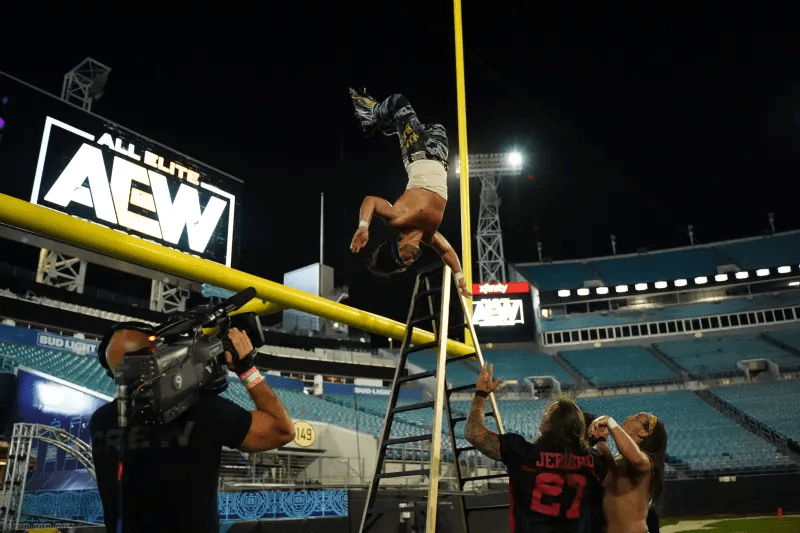
Photo courtesy of AEW
Before the coronavirus really took hold, AEW had been building to its biggest match ever: a Blood and Guts match between The Elite and the Inner Circle. Essentially, it was a WarGames match between the two dominant factions in the company. Once the pandemic and the subsequent quarantine started, though, AEW decided to shelve that match indefinitely and in its stead we got the Stadium Stampede match at Double or Nothing. Honestly, it might have been a blessing in disguise, given what we got.
The Stadium Stampede match was as stupid and ridiculous as its name would imply. The two teams, with Matt Hardy replacing Cody Rhodes due to the golden boy’s TNT Championship match earlier in the night, fought in an empty TIAA Bank Field in Jacksonville. More accurately, they fought all over it, from the field to the stands to the backstage area.
The moment-by-moment highlights are too long to list here, so let’s focus on two. First, the Inner Circle’s Santana and Ortiz double-teamed Matt Hardy in a random pool that exists in the stadium because Florida. As they attempted to drown him in the pool, Hardy would come back up in different personas from his past: first, he popped up as his Hardy Brothers character, then as Big Money Matt, and finally as his “Broken” gimmick from Impact Wrestling, which he has carried over into AEW.
More interestingly and elsewhere in the stadium, Hangman Page, the possibly alcoholic and definitely depressed handsome cowboy, shared a drink with Jake Hager in one of the stadium’s bars, before erupting into a good ol’ fashioned bar fight that also included Kenny Omega smashing multiple bottles over Hager’s head alongside Page. After taking out Hager, the two shared a drink; Omega pounded a glass of milk, while Page shot back some whiskey.
There were other memorable spots throughout, such as Matt Jackson suplexing Sammy Guevara from end zone to end zone, and while it might have been too much in a normal year, it was exactly what the company needed at the start of the pandemic. Everyone was sad and lonely, and watching these ten idiots brawl all over an empty football stadium was as good as anyone could have hoped for in their entertainment. It wasn’t the best match, technically, but it might have been the Best Match for what they could do. — Luis Paez-Pumar
8. Rhea Ripley vs. Io Shirai (NXT Women’s Title Match) (NXT Episode #430; World Wrestling Entertainment)
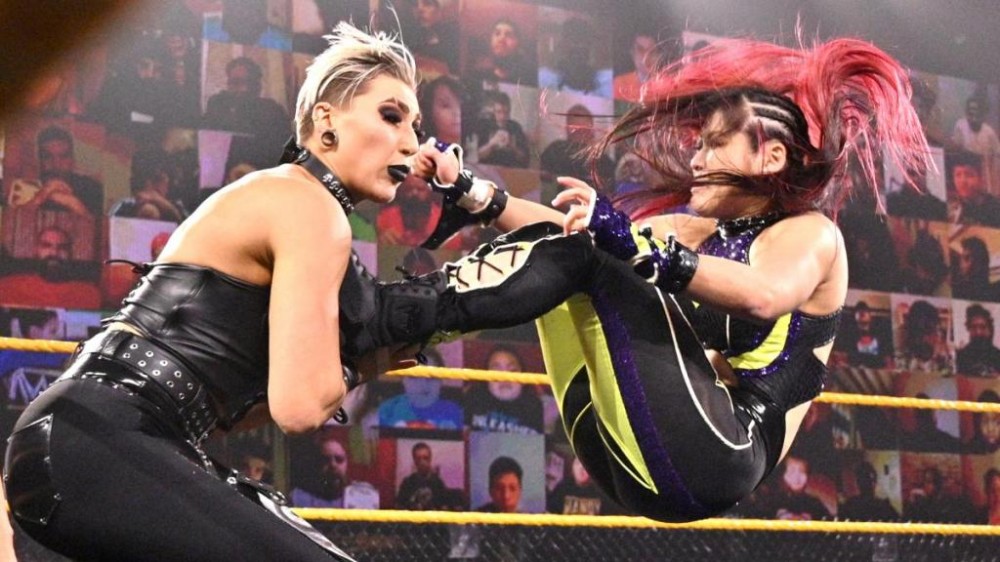
Photo courtesy of WWE
In the run-up to Charlotte Flair choosing to challenge the then-NXT Women’s Champion Rhea Ripley with her Royal Rumble win, it appeared as though Ripley was being set up to become WWE’s next megastar. Then, she ran into the brick wall of Charlotte’s famous last name (and yeah, her talent too) and spent most of the remainder of the year making stars in NXT instead of rising to the top of the main roster. Meanwhile, the skills, the mystique, and the singularity of Io Shirai — who secured her first NXT championship reign by pinning Ripley — has made her one of the five best wrestlers in the world and the top of the cool list.
After Flair won the NXT Women’s Championship at Wrestlemania and lost it without being pinned in the main event of June’s Takeover: In Your House card, leading to Shirai’s still-running championship reign, all roads were leading back to Ripley challenging Shirai eventually.
The pace of the match was brisk given its relative brevity, and highlighted its sense of urgency. The match was stiff in a way that fell in line with the best of NXT late in 2020, after it seemed as though the bouts were getting as overproduced as main roster WWE for much of the year. Shirai was laying her shots in, nailing a dropkick square in the mouth of Ripley and somehow bloodying her ear at some point. Ripley looked like a badass while marking her own blood under her eye like a Norse warrior. The missed spot when Shirai slipped on the ropes early on made the match feel more real and less rehearsed.
A German suplex off the second turnbuckle leading to the dive turned into a sunset flip powerbomb through the announcer’s table leading to Shirai hitting her killshot moonsault on the back of a prone Ripley was a top-notch sequence on par with the best finishes of the year. The match as a whole was a punishing display of how the age-old size advantage can be ruthlessly exploited by a savvy champion ready to push through any physical or emotional limits to keep what’s hers. — Douglas Martin
7. Eddie Kingston vs. Jon Moxley (“I Quit” Match for the AEW World Championship) (Full Gear; All Elite Wrestling)
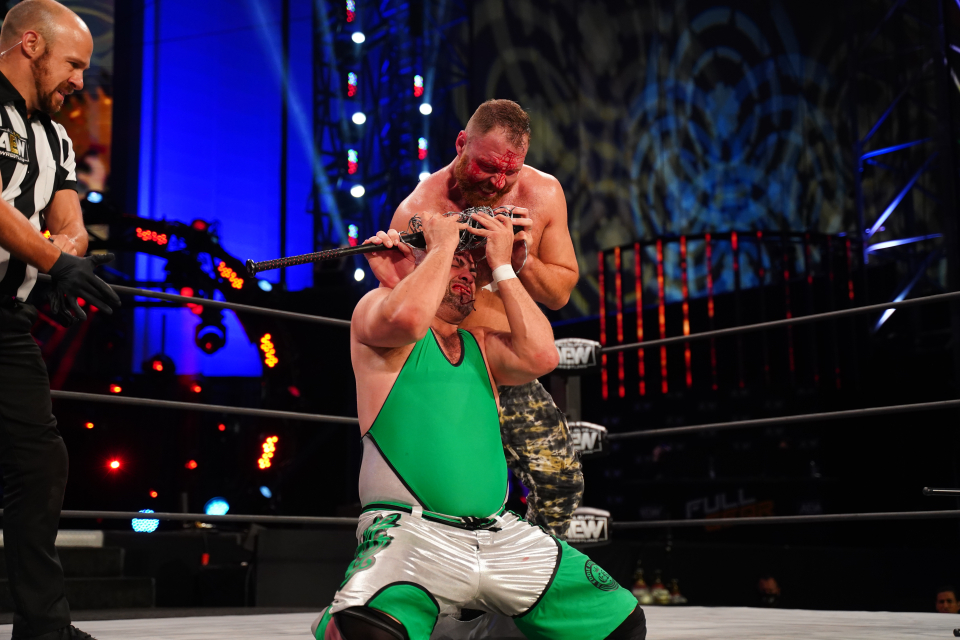
Photo courtesy of AEW
Eddie Kingston, the hardscrabble indie veteran from Yonkers, NY, doesn’t scream TV Wrestling World Champ. His gear is notably old school and low budget, a cross between a singlet and tights, showing how he’s stuck to his roots. Roots that many worried he was permanently tethered to. Kingston’s arrival in AEW, though, felt like enough of a win for his fans and faithful. But for The Mad King to then be main-eventing a PPV? It just gave everybody a taste that a better way was possible.
One of the greater injustices of the COVID Wrestling era rests in the fact that Eddie Kingston, the dark heart and soul of pro wrestling, main evented a major North American PPV without a packed house. Jon Moxley is beloved, but Kingston’s army would have been equally loud and it would have been one hell of a night. The story is simple: this was an “I Quit” match because Kingston believed that he should be the champ. He wasn’t eliminated from the #1 contender’s match, and he did not tap out to Mox before — referee Bryce Remsberg called the match to protect Kingston (playing into their decades of shared ring experience in companies we don’t talk about anymore).
And right when it seemed like the story going into the match was thin, Mox blamed Kingston for taking this too far, and took it even further by bringing up Eddie’s mom — and how they shared a table, where Mox promised he’d take care of her son.
So when Mox and Kingston entered through the tunnels at Full Gear, the animosity was searingly hot. And so they went to war with all the nastiest elements they could. Thumbtacks and steel chairs? Too simple. Eddie soon poured rubbing alcohol on Mox’s open wounds, an action that I could not remember seeing on TV wrestling in a while. Not only did Mox writhe on the mat like a snail under salt, but even Remsberg (brought back to continue his part) screamed in sympathy pains. In the end, Mox’s barbed wire baseball bat needed a slight modification: the baseball bat was lowering the overall potential pain. Like something out of The Boys, Mox took off the barbed wire and dug it into The Mad King’s face while applying the bulldog choke.
Kingston, in too much pain to do anything but, said “I quit.” His enunciation, through the pain and the submission, reveal everything you need to know about his wounded pride. — Henry T. Casey
6. Best Friends vs. Santana & Ortiz (Parking Lot Brawl) (Dynamite Episode #50; All Elite Wrestling)

Photo by Lee South, courtesy of AEW
AEW has a stacked lineup of incredible non-wrestling managers, but with apologies to the mic skills of Arn and Tully and Taz and Jake Roberts and Vickie Guerrero, the company’s most valuable manager in 2020 was Trent’s mom Sue. She didn’t say anything on mic and was never ringside for Best Friends’ matches, but instead, she offered something far more crucial—she ignited the blood feud between Best Friends and Santana & Ortiz.
Sue’s debut came during Fyter Fest in July when Best Friends wrestled for Adam Page and Kenny Omega’s tag titles. Rolling up in an expensive vehicle was the entrance du jour on Dynamite—Cody had just done it, FTR debuted that way—so Best Friends took a page out of that playbook when they were dropped off at Daily’s Place in a white minivan driven by Sue. Trent exits the van lookin’ mean as hell when his mom calls him back. “Greggie,” she says, ”Come here, I need a kiss!” Fuck the beer truck or Triple H’s skeleton king four-wheeler—this is the best automotive entrance in wrestling history.
One month later, the camera cut to Chuck and Trent rolling up to a taping of Dynamite in Sue’s van; commentary makes a point to tell the audience that the boys were asked to “park it somewhere safe.” (Uh oh.) They beat Santana & Ortiz with a quick rollup, infuriating their opponents. (Uh oh!) Filled with rage, Proud & Powerful headed to the parking lot with a sledgehammer and wrecked Sue’s van. (Uh oh!!!) They busted windows and tagged the word “SUE” on the hood. “Tell your moms we said what’s good,” Santana said. The episode ended with a livid Trent demanding that they apologize to Sue—“on speakerphone.”
Suffice to say that apology never came, and after another month of gradual feud building, the four men finally clashed in a main event parking lot brawl on Dynamite. Highlighting individual spots does this match a disservice, because what rules about this parking lot fight is how there’s never a lag in its overall flow. It’s just brutal moment after brutal moment. And it’s not a precious, over-choreographed affair either—there are some clear human flubs that happen, like when Trent catches himself in the face with a plank of wood he’s using as a weapon.
And while this match is more than the sum of its parts, oh man are these parts very good:
- Santana getting his head busted open on a rearview mirror within the first minute of the match. (He’s said he thought it was going to bend back like most rearview mirrors do. It did not.)
- Ortiz getting slammed between the hood and engine block of a car with a senton. (This moment, he said, took the wind out of him completely.)
- Ortiz throwing a sledgehammer like a javelin toward Chuck, who dodges it and it goes through a windshield.
- Chuck suplexing Ortiz onto a propped up steel bicycle railing, bending it in half on impact.
- Trent getting powerbombed into a windshield, ripping his back open with shards of broken glass. (This was after he was powerbombed onto the roof of the car.)
The climax of the match featured a surprise trunk pop, Orange Cassidy knocking out Santana with a chain-assisted Orange Punch, and some final brutality with dual piledrivers onto cars. And then, these blood-covered boys piled into Sue’s pristine white van. She flipped the bird to an already-defeated Santana & Ortiz and drove off with her bloody son and his exhausted friend.
If you note the timeline here, Sue did exactly two things throughout this story: she drove in, and she drove away. The blood spilled and damage caused in the name of avenging that woman’s minivan reached samurai movie levels of poetic justice. It’s incredible work. We would all like a kiss, Greggie. — Evan Minsker
5. Sasha Banks vs. Bayley (Hell in a Cell Match for the Smackdown Women’s Championship) (Hell in a Cell; World Wrestling Entertainment)
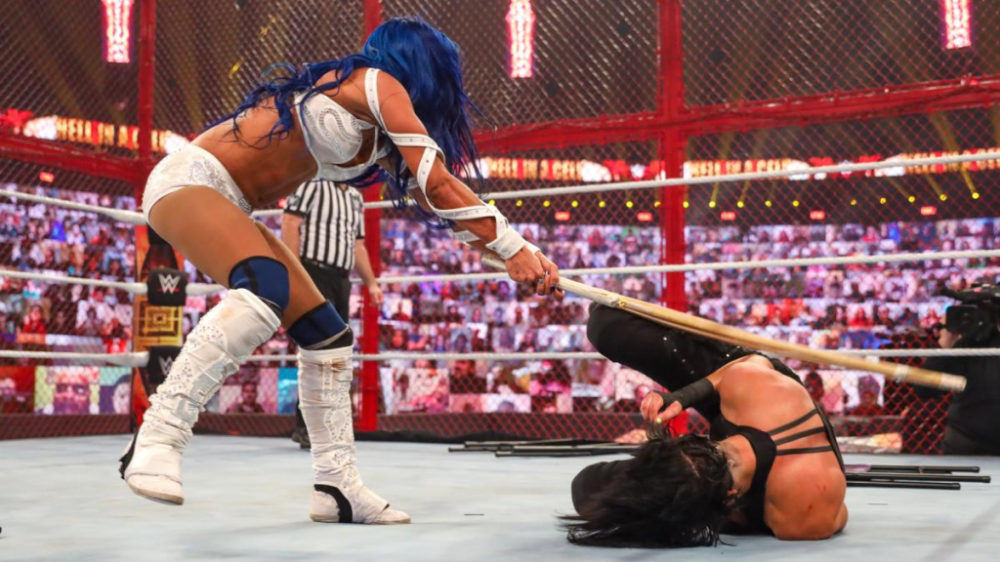
Photo courtesy of WWE
To say Sasha Banks and Bayley carried WWE in 2020 is an understatement. The pair held down the women’s divisions on both Raw and SmackDown for months, first as their usual frenemies characters and then as a team called the Golden Role Models. The duo at one point held both of the shows’ main titles and the women’s tag team belts, and the storylines followed suit. Of course, this is wrestling, so it would all come apart. The blow-off for their resulting feud was worth blowing up the best run in the company, though, because what we got was one of the very best Hell in a Cell matches of all time.
As is appropriate in blood feuds between former friends, the action started heavy, with Banks attacking Bayley off the rip, sending the champion’s chair outside of the cell, evening the playing field from the start. What followed was a 30-minute melee that, somehow, invented new spots in a match that has been driven into the ground by WWE’s insistence on having two every single year. (I am of the mind that this pay-per-view should be done away with, and the cell should only be brought out for feuds that deserve it; either way, this one did, so no harm no foul there.)
Banks was the star here, as she usually is. From the early Meteora knee strike using a propped up table as a ramp and the cell as a stand-in from the ring mat, to reversing a throw into the ring into a hurricanrana that smashed Bayley’s face into the cell, to the sunset flip powerbomb that clanged the champion off the cell. Bayley was no slouch, either, and was the aggressor in my favorite moment of the match: after Banks had set up two kendo sticks between the stairs and the cell, Bayley wheelbarrowed her up into them, essentially trying to cut Banks in half. It was great.
Though they deserved a crowd for this classic, these two proved that they have the best chemistry of any pairing in wrestling; these are the same two that had a banger five years ago at NXT Takeover: Brooklyn I, after all. And though they have moved on to other feuds since the stretch at the end of 2020, these two made the most of their moment in October. Violent, creative, and emotionally satisfying, the hell that these two women went through in the cell was a fitting send-off for the best storyline of the year. — Luis Paez-Pumar
4. Kota Ibushi vs. Kazuchika Okada (IWGP Heavyweight Championship Match) (Wrestle Kingdom 14 Night 1; New Japan Pro Wrestling)
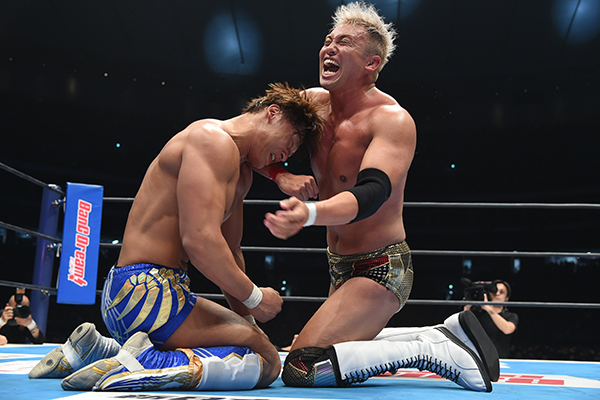
Photo courtesy of NJPW
When Kota Ibushi speaks on ascending to the God Level of professional wrestling, we already know the totems to which he is referencing. It’s easy to see why Kazuchika Okada doesn’t bear inclusion on Ibushi’s influences list — for starters, Okada is nearly five and a half years his junior — but I’m sure if you’re reading this list you’re already aware Okada is a god tier pro wrestler. He was IWGP Heavyweight Champion — a distinction which in my opinion puts you closest to being the objective best wrestler in the world — for 10 days short of a full two years; a run which earned him higher star ratings than the Big Dipper. And that was just one of his five reigns with the championship.
For his part, Ibushi had long been considered one of the greatest wrestlers to never hold a top championship for a major wrestling company. There’s not much I can say about his unpredictable brilliance that hasn’t already been said; in every conceivable category, he’s the platonic ideal of a pro wrestler. It was only a matter of time before he won the grueling G1 Climax tournament and punched his ticket to the main event of Wrestle Kingdom.
The normally chaotic Ibushi becomes outright homicidal in his calculatedness against Okada, appropriate for the skill of his opponent. It’s a good way to adjust your approach against arguably the greatest wrestler of a generation.
January 4th at the Tokyo Dome, when the lights are on brightest. Of course, this is the second part of a three-part series known as the “Double Gold Dash,” where both IWGP Heavyweight and Intercontinental Championships were up for grabs, and Wrestle Kingdom was held over two nights for the first time in 2020, where Ibushi is going up against one of the most solid crunch time players in all of pro wrestling.
As the match begins, Ibushi (self-taught savant) and Okada (model student turned golden boy) quickly move from the feeling out process to coming to blows and grinding each other downy. Not too long into the match, Ibushi fires a kick to Okada’s chest which sends the champion doubled over on his knees. At various points, Okada dares Ibushi to hit him with his best shot, which ultimately becomes a “be careful what you wish for” situation.
About ⅔ of the way through, Okada starts leveling uppercuts on the chin of Ibushi. One shot, two shots, three shots, four. Ibushi no-sells them all with a stoicism foreign to what we’ve seen from the Golden Star. After a fifth shot, Ibushi nails a nasty palm strike straight into the upper chest of Okada, coming dangerously close to his throat. He kicks Okada hard. Okada returns with a shotgun dropkick but Ibushi blacks out and knocks him down with stiff punches; while Okada’s down, Ibushi lets off hard, taunting kicks. Okada covers up while Ibushi rains hard punches on him, to the point where the aghast audience starts to boo him.
The first time I watched this match, my eyes grew wide and I leaned forward in my seat. There was no suspension of disbelief; only the disbelief of being so shocked this was happening.
The third act of the match scales to a climax for the night starting with Okada hitting Ibushi with a Tombstone piledriver on the apron. Not too long after, Ibushi returns with that second-rope-assisted German suplex I went nuts for in 2014 and eventually nails Okada with his own finishing move. Ibushi summons one of his gods, Shinsuke Nakamura, by hitting a Bomaye; Okada kicks out at one. Hard strike exchanges and finisher moves abounds, it’s like the wrestling equivalent of nothing but triples and home runs from the 7th inning stretch until the end of the game. Ibushi provides an immense challenge for a generational wrestling touchstone, but after reversing Kamigoye into a fourth Rainmaker lariat, Okada finally emerges victorious.
Okada and Ibushi have individually collected enough evidence to show wrestling is the most visceral art form on earth, but together, for the richest prize in their world, they take it to a phrase Okada is fond of saying: “A whole different level.” — Douglas Martin
3. Kyle O’Reilly vs. Finn Balor (NXT Championship Match) (NXT Takeover 31; World Wrestling Entertainment)
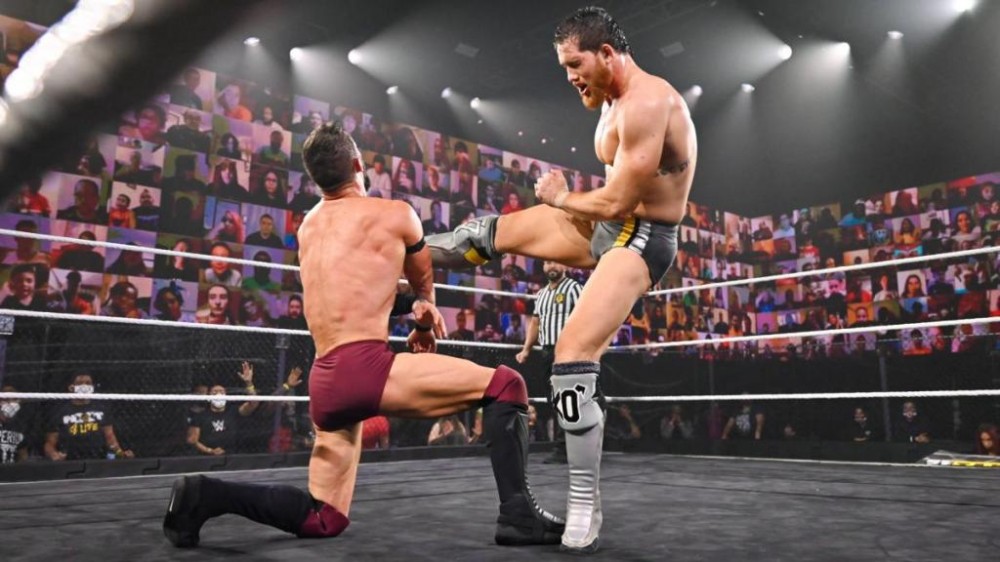
Photo courtesy of WWE
To quote Excalibur, “You’ve got to give the people what they want!” And in 2020, that meant the rise of Kyle O’Reilly. Audiences familiar with his previous work — he won PWG’s BOLA in 2013 for crying out loud — knew that NXT had a somewhat secret weapon in KOR, who’d only worked tag matches so far. And so, out of the chaos of an injury-plagued main event scene, Kool Kyle found his way — but didn’t change his tune. Entering the arena on his own, rocking the air guitar, O’Reilly was approaching this match with a touch of the goofiness that made him the consistently lovable one of the heinous Undisputed Era.
NXT Takeover main events, with rare exceptions, are reliably chock-full of whatever “workrate wrestling” means. But what changed this time is that we went from strong style to painful style. Finn Bálor, having returned to the not quite-main roster brand to revitalize his career, demonstrated why his claims of royalty are not overhype. Not only did Bálor strike hard and fast, he made O’Reilly look like a star and a force to be feared, at one point dropping to the ground to almost beg for mercy when Kyle was going in for the kill. O’Reilly’s Brazilian Jiu-Jitsu expertise, though, ultimately is the element that made his performance special. Augmenting his arsenal of leg strikes with a series of heel hooks and grapevine leg logs, O’Reilly thrived on his own. And while Bálor left the match with the gold, he wasn’t the man he was when he entered, with a bloodied mouth and swollen jaw.
These accidents of war are not the kind of thing you’re supposed to see in pro wrestling. You’re supposed to protect your dance partner. But when NXT needed a shot in the arm and something different to stand out (this may have been one of its lesser years overall), Bálor and O’Reilly delivered, and the latter earned a recurring spot in the main event scene. — Henry T. Casey
2. Cody Rhodes vs. Brodie Lee (Dog Collar Match for the TNT Title) (Dynamite Episode #54; All Elite Wrestling)
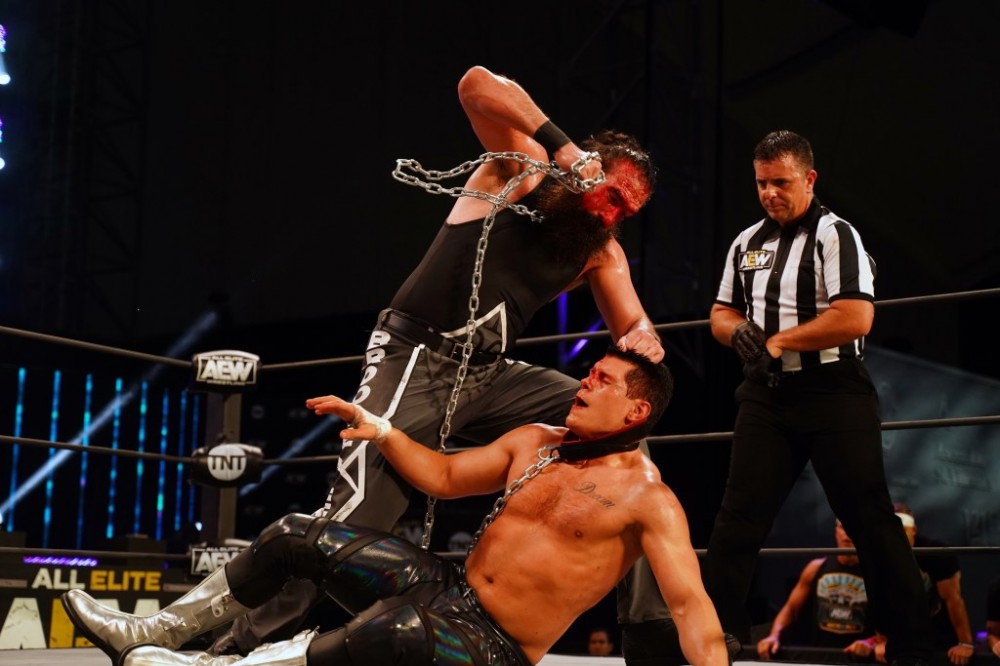
Photo by Lee South, courtesy of AEW
The dog collar match was Brodie’s idea. One of his favorite fights ever was the legendary Greg Valentine and Roddy Piper fight. Faced with following up the unceremonious squash of the once and future Cody Rhodes, he blurted out the idea. “He watched every dog collar match that he could get his hands on and he was like ‘I don’t like these—I’m gonna have a better one,’” his old friend Chris Harrington said. It would be Brodie’s final match.
After the better part of a decade adhering to Vince’s vision of wrestling, Jon Huber’s final year in AEW was a gift. The rebirth of Brodie Lee showed that one of the E’s most underutilized and underrated talents was indeed everything you’d hope he’d be in a world where he’s booked appropriately. He was a final boss. He was a gift on the mic. You want a big man to show up with authority and screaming intensity and flawless ring work? Brodie was that guy. You want a world title challenger to take a finisher through the stage floor, crawl out with blood all over his face, and then get choked out thereby making champ, challenger, and title all look better in the process? That was Brodie in his sole AEW World Championship match.
In August, Cody lost his TNT Championship to Brodie in a spectacular squash that established the Dark Order’s fearless Exalted One as an enormous threat. Brodie just wrecked Cody—throwing him around, landing stiff shot after stiff shot, and finally putting him down with a discus lariat. Cody spent the following weeks off TV for the first time due to “injury” (he was taping the reality competition series Go-Big Show) while Brodie kicked his brother Dustin’s ass and defended against Orange Cassidy.
Then, one day, Cody came back to television to confront Brodie. “THE AUDACITY OF YOU, CODY, TO RETURN LIKE THAT,” Brodie screamed into the camera. “YOU HAVE BEEN GONE FOR FIVE WEEKS WHILE I’VE BEEN HERE DOING THE WORK.” He hoisted a dog collar in his fist and screamed out his challenge. Cody accepted a week later in an also-strong promo (though if we’re gonna nitpick, it was a weird decision to flex about his reality show friendship with Rosario Dawson in that spot). Regardless, the world felt lighter. No matter what hellscape awaited the week of October 7, there would be a full-on dog collar match on cable TV (a first!). I was excited to see what magic Brodie and Cody could make in such a historically brutal format, and I was excited for Brodie that he could be in this position.
Watching it that Wednesday night was riveting, but the context of watching it back knowing it’s Brodie’s last match ever is heartbreaking. It stands as a sign of what could have been if he was still with us today. But it’s also genuinely moving to see how he’s treated as a genuine monster in this match. After devastating Cody weeks earlier, it took countless truly brutal-looking shots to keep Brodie down in the dog collar match. Cody dragged Brodie by the chain and neck into a cutter on the floor. Brodie got scooped up by Cody into a package piledriver through a table, which busted Brodie open to the point where he spent the remainder of the match with blood pouring from his forehead to his beard.
He got punched in the bleeding head repeatedly with a chain-wrapped fist, was whipped in the back with the length of the chain, and choked out while with the collar’s chain wrapped around the ring post. And for as much as punishment Brodie took, he definitely laid in some intense offense, like the sequence where he threw Cody over the railing and into the crowd, giving him the space to grab the chain and pull his rival repeatedly into the steel partition (not to mention the chain-assisted Bossman Slam and powerbomb).
In hindsight, one of the best things about this match is how Brodie gave some shine to Arn Anderson throughout. In this story, Arn was Cody’s coach—one member of a massive entourage that got put down by Brodie’s Dark Order weeks earlier. But in reality, Arn had been a champion of Brodie’s throughout his time at WWE. The two men were close, and before the match, Brodie got on mic and pointed over at his mentor: “Arn Anderson, shut your damn mouth!” Later in the match, Arn was standing on the apron, which pissed Brodie off to the point where he threw a chair at his head. Arn, of course, stormed the ring. Double A hit Alex Reynolds with a spinebuster, and then Brodie punched the legend in the breadbasket with a chain-wrapped fist.
The match ended in a truly spectacular fashion. Brodie got trapped in a submission where his blood-covered face was wrapped around the mouth, nose, and eyes with the chain. He took Cody’s Cross Rhodes finisher—at that point for the second time—with a chain wrapped around his neck multiple times. And that’s what it took for Brodie to lose the belt. Cody spent the match flying around the ring, doing moonsaults and tope suicidas, while Brodie absorbed the kind punishment reserved for an unstoppable monster.
This shouldn’t have been the last Brodie match. His work with Dark Order was only just beginning and he had so many post-WWE dream matches left in the tank. When an artist dies not long after they share an iconic work, it’s harrowing to revisit and tempting to attempt to glean some greater meaning therein. It wasn’t planned that way, but the dog collar match was the last stop—one where he made his opponent look incredible, gave his mentor Arn Anderson and protege John Silver some crucial moments in the spotlight, and in the process, he showed why he was one of the great big man wrestlers going. Brodie delivered a classic dog collar match with Cody. That was the goal, he did it, and the rest of us will always have this. — Evan Minsker
1. The Young Bucks vs. “Hangman” Adam Page and Kenny Omega (AEW Tag Team Title Match) (Revolution; All Elite Wrestling)

Photo courtesy of AEW
AEW’s best success in its first full year as a company was the rise of Hangman Adam Page. From a bland babyface who wasn’t particularly loved at the start of this whole thing, Page turned into a loner, drunk cowboy who could go in the ring and had nearly every fan in his corner. It was a wonderful transformation, and one that drove the storyline behind the best match of the year. Though Page and Kenny Omega were thrown together in one of my least favorite tropes—two top singles wrestlers teaming and beating established pairs—it worked because there was a clear tension between the two, thanks to Page’s idiosyncrasies.
On the other side of their match at AEW Revolution were the Young Bucks, fellow members of The Elite and trolling antagonists. The Bucks were not shy about picking at the scabs of Page and Omega’s relationship, setting up what could have been a boring face-vs-face match into something more intriguing, and darker. All of that wouldn’t matter, though, if the match didn’t deliver. Luckily for everyone involved, the Bucks almost always deliver, and the team of Page and Omega is talented enough even with tension to come up as big as they did on February 29.
As you might expect from a Young Bucks match, there were spots to boot here. The ostensible storyline for the action was that Matt Jackson had a back injury, and the team of Page and Omega, particularly the cowboy, picked on him for it. It didn’t hurt the story of the match that the Chicago crowd was going nuts for anything Page did, even a fallaway slam. Chants of “Cowboy shit!” exploded regularly throughout, and for Page, who hadn’t had much fan support at the start of his AEW run, it seemed to really drive him to match the other wrestlers, who could be considered better performers by sheer resume, blow for blow. He even hit a moonsault to the outside on both Bucks, landing on his feet in the process.
For their part, the Bucks went deep into their own bag of tricks, hitting all of their signature moves, and even stealing Omega’s tag-team move with Kota Ibushi, the Golden Trigger. They got an extremely close near fall on Page with a Canadian Destroyer, they hit an IndieTaker on Page on the ramp, and of course there were many superkicks. The one move they could not hit, however, was their Meltzer Driver finisher, thanks to Page stopping it as the brothers attempted to land it on Omega. For their part, Omega got his patented comeback in, though it was cut short by the Bucks, and Page landed a powerbomb on Nick Jackson through a table. If it feels like I am just listing spots, well, there was a lot in this 34-minute spectacle.
The finish was sublime. As Omega failed to get Matt Jackson over for the One-Winged Angel, Page tagged himself in behind Jackson’s back and landed his own version of the move. Nick Jackson was able to break up the pin, but there was no way that Page was going to lose after that. One Buckshot Lariat to each brother followed soon after, taking out Nick on the outside before knocking Matt out for the win.
That wasn’t the true end, though, and it’s really the post-match that elevated this to the landmark moment in wrestling for 2020. Though Page and Omega had been teasing a break-up or at least a scuffle, they left together, though not before Page made it clear that he was done with the Elite … for now. He rejected hand raises and hugs from his fellow stablemates, finally breaking off into his own, a well-deserved ride into the sunset for the cowboy that finally reached the top of the mountain. — Luis Paez-Pumar

